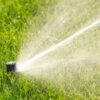Sprinkler systems are designed to simplify landscaping maintenance through automated watering. Properly designed and maintained systems help homeowners keep turf and plantings healthy with minimal effort. Once the initial schedule is set, though, some systems are left to run indefinitely. This “set-it-and-forget-it” approach can lead to significant water waste and increased utility costs.
Signs of Water Waste
1. Excess Water Runoff
Water flowing from landscaped areas onto paved surfaces, like driveways or sidewalks, can indicate overwatering. That runoff occurs when soil cannot fully absorb water as quickly as it is being delivered – often due to sprinkler heads applying water too rapidly or running for extended periods of time. This not only wastes water but also contributes to soil erosion, which drains the soil of necessary nutrients.

Dry patches may tempt homeowners to run sprinklers longer, but sprinkler heads are often the real issue.
2. Uneven Growth & Dry Patches
Turf with signs of uneven growth or dry patches can be a result of misaligned or clogged sprinkler heads. When sprinkler heads cannot disperse water evenly, some areas of grass receive too much water while others are missed completely. This can lead homeowners to extend watering sessions unnecessarily to address the missed sections.
3. Watering When Raining or Windy
Sprinklers still running before, during, or after rainstorms, or on particularly windy days, can be an indication that the irrigation system is wasting considerable amounts of water. Advanced systems utilize sensors or smart controllers that track real-time weather conditions to skip or delay watering sessions when they are not needed.
4. Sprinklers Hit Hardscaped Areas
Spray patterns must be carefully set to run efficiently and cover each zone of the property evenly. Hardscape areas, such as patios, driveways, and decks that get extremely wet during watering sessions are a sign that sprinkler heads are misaligned and are wasting water.

Set sprinklers to run sometime between 5-8 am.
5. Watering at the Wrong Time
Sprinkler systems should be set to run early in the morning, especially during the hottest month of the year. While it may seem logical to water grass when the daytime temperature is at its highest, water is actually being wasted. Intense heat and sun cause water to evaporate before the soil can properly absorb it. That, in turn, may encourage owners to run sprinkler systems longer to compensate for the loss of water and reach adequate levels of moisture in the soil. Watering in the early morning hours gives the water enough time to be absorbed, and any excess droplets will evaporate as the sun rises.
6. Lack of Sprinkler Maintenance
Regular maintenance is a must to keep sprinklers functioning at their highest levels of efficiency. This helps prevent breakdowns and catches any problem areas early before they can cause any unexpected water waste. Plus, a well-maintained system significantly reduces the need for costly repairs and replacements.
If you suspect your irrigation system is not running as efficiently as it should, call the irrigation specialists at Heinen. The team of experienced professionals at Heinen can assess all types of irrigation systems, recommend strategic solutions, and complete all necessary repairs and upgrades!








